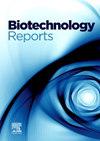基于纳豆素的多肽的设计提高了抗菌和抗病毒活性。
Q1 Immunology and Microbiology
引用次数: 0
摘要
多年来,动物毒液的生化分析一直在加强,能够预测来自毒素的新分子,利用这些分子的治疗潜力。从海苔鱼(Thalassophryne nattereri)的毒液中,利用计算机预测抗菌肽和穿透细胞肽的方法,合成了两种具有良好特性的海苔蛋白肽,并进行了体外和体内分析。对制备的多肽进行了稳定性试验、抗菌试验、小鼠成纤维细胞毒性试验、基孔肯雅病毒抗病毒试验和对大麦伦氏杆菌的毒性试验。这一发现强调了肽在不同温度和pH条件下的强大稳定性以及对蛋白质水解降解的抵抗力。这些肽显示出显著的抗菌功效、最小的细胞毒性和低溶血活性。尽管它们的抗病毒功效有限,但它们在病毒复制的特定阶段显示出潜力。体内毒性试验表明具有良好的安全性。这些发现表明,这种方法可以帮助开发抗菌药物,提供一种更快和个性化的方法来对抗微生物感染,并代表了毒液生物技术研究的一个有希望的发现。本文章由计算机程序翻译,如有差异,请以英文原文为准。
Design of Natterins-based peptides improves antimicrobial and antiviral activities
The biochemical analysis of animal venoms has been intensifying over the years, enabling the prediction of new molecules derived from toxins, harnessing the therapeutic potential of these molecules. From the venom of the fish Thalassophryne nattereri, using in silico methods for predicting antimicrobial and cell-penetrating peptides, two peptides from Natterins with promising characteristics were synthesized and subjected to in vitro and in vivo analysis. The peptides were subjected to stability tests and antimicrobial assays, cytotoxicity in murine fibroblast cells, antiviral assays against the Chikungunya virus, and the toxicity on G. mellonella was also evaluated. The findings underscore the peptides' robust stability under varying temperatures and pH conditions and resistance to proteolytic degradation. The peptides demonstrated significant antimicrobial efficacy, minimal cytotoxicity, and low hemolytic activity. Although their antiviral efficacy was limited, they showed potential at specific stages of viral replication. The in vivo toxicity tests indicated a favorable safety profile. These findings suggest that this approach can aid in the development of antimicrobial agents, offering a faster and personalized method to combat microbial infections, and represent a promising discovery in venom biotechnology research.
求助全文
通过发布文献求助,成功后即可免费获取论文全文。
去求助
来源期刊

Biotechnology Reports
Immunology and Microbiology-Applied Microbiology and Biotechnology
CiteScore
15.80
自引率
0.00%
发文量
79
审稿时长
55 days
期刊介绍:
Biotechnology Reports covers all aspects of Biotechnology particularly those reports that are useful and informative and that will be of value to other researchers in related fields. Biotechnology Reports loves ground breaking science, but will also accept good science that can be of use to the biotechnology community. The journal maintains a high quality peer review where submissions are considered on the basis of scientific validity and technical quality. Acceptable paper types are research articles (short or full communications), methods, mini-reviews, and commentaries in the following areas: Healthcare and pharmaceutical biotechnology Agricultural and food biotechnology Environmental biotechnology Molecular biology, cell and tissue engineering and synthetic biology Industrial biotechnology, biofuels and bioenergy Nanobiotechnology Bioinformatics & systems biology New processes and products in biotechnology, bioprocess engineering.
 求助内容:
求助内容: 应助结果提醒方式:
应助结果提醒方式:


